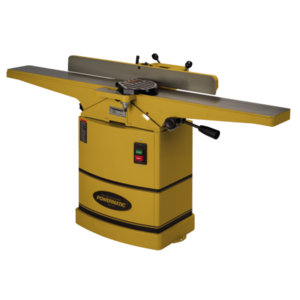Difference between revisions of "Jointer"
| Line 52: | Line 52: | ||
====Demonstration==== | ====Demonstration==== | ||
| − | Demonstrate you can safely setup the jointer. You will need to clean up one | + | Demonstrate you can safely setup the jointer. You will need to clean up one edge and one face of a board. Remember to never adjust the out feed table as it has been precisely set to the height of the cutter head. Adjusting the in-feed table will change the amount of material removed per pass. Do not set the in-feed table to remove more than 1/16" per pass. Your fingers should never go any lower than the height of the cutter guard. Verify the fence is locked and set at the angle needed before making a pass. |
====General Procedure==== | ====General Procedure==== | ||
Revision as of 16:36, 24 October 2019
Make: Powermatic
Model: 54HH
Ace: Needed (Makerhub@georgefox.edu).
Location: Wood Shop
Description
The Powermatic jointer contains a 1HP motor and 6" capacity that will handle the most demanding work. The helical cutterhead provides quieter operation and finer finishing than conventional systems. The 4" dust port connects easily to any dust collector. Used to remove material from wood, as well as squaring to create straight pieces.
Here is an example of this piece of equipment being used.
Documentation
Terminology
- Cutter Head - Drum of carbide inserts that perform the cutting.
- Fence - Metal back-stop that is used to guide and control the angle of material being cut.
Training
Overview
Insert Text
Demonstration
Demonstrate you can safely setup the jointer. You will need to clean up one edge and one face of a board. Remember to never adjust the out feed table as it has been precisely set to the height of the cutter head. Adjusting the in-feed table will change the amount of material removed per pass. Do not set the in-feed table to remove more than 1/16" per pass. Your fingers should never go any lower than the height of the cutter guard. Verify the fence is locked and set at the angle needed before making a pass.
General Procedure
Rip Cut
1. Ensure that the material you are cutting has at least one straight edge and no nails or foreign objects. The straight edge will slide against the fence when ripping.
2. Measure the width of the board and determine the width of cut desired.
3. Lift the locking handle on the fence and slide the fence to the desired cut width using the scale. Make sure you use the scale for the correct side of the blade.
4. Lock the fence by pressing down on the locking handle.
5. Use the elevation handle on the front of the saw to set the height of the blade approximately 1 tooth above the height of the material by placing the material next to the blade as a guide. This limits the exposed blade.
6. Turn on the main power switch on the front of the saw and the dust collector. The green light on the saw will flash and turn solid green when the saw is ready.
7. Make sure nothing is touching the blade. Turn on the saw by gently pulling on the red start paddle switch located on the front of the machine. The paddle switch is also the off switch when pressed.
8. Line up the flat side of the material with the fence without touching the blade. The fence is a guide and the material should be pressed firmly into the fence as well as down on the table. If the board is warped make sure that curved side is face downward.
9. Slowly feed the material in towards the blade while keeping your fingers at least 6" from the blade. Use a push stick to keep fingers away from the blade.
10. Make sure you keep a firm hold on the material and do not stop feeding the material until it has passed beyond the blade.
11. It is helpful to have someone assisting on the back side of the saw to help hold material being fed off the table. Make sure the person helping does not pull on the material.
12. When the saw cut is complete, press in on the paddle switch to turn off the saw and lower the blade below the table to keep anyone from accidentally cutting themselves.
Safety
There are several hazards you need to be aware of when using a jointer.
- The cutters are very sharp and spin very fast. Keep your fingers away from the cutter head even when its not spinning. Use a push pad/stick to keep your fingers a safe distance from the cutters.
- Never let your thumb or fingers hang down near the table when pushing a board through the machine.
- Hold onto material firmly and keep it against the table and fence to help prevent material kicking back. If material catches on the blade the material can shoot back at you and this is called a kickback.
- Use a hold down or push block when surfacing stock less than 12" long, or 3 inches wide, or 3 inches thick.
- Never feed material backwards.
- Never try to cut across grain as this could cause a kickback.
- Don't exceed 1/16" cut per pass.
This is a video showing how to safely use the jointer:
Certification
Troubleshooting
Maintenance
General maintenance
Insert text
Specific Maintenance Tasks
| Maintenance Procedure | Frequency | Done By |
|---|---|---|
| Sample | Sample | Sample |
